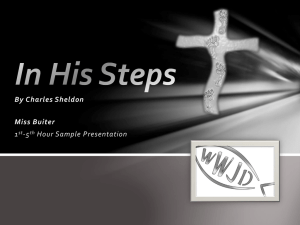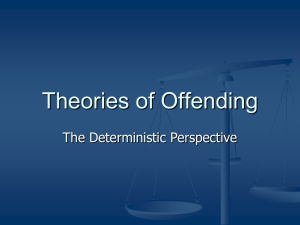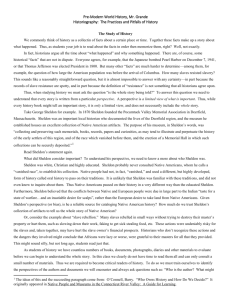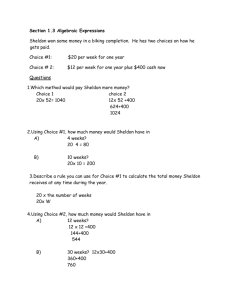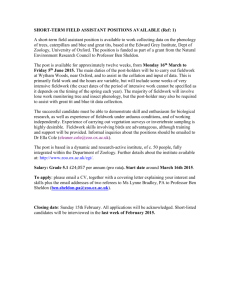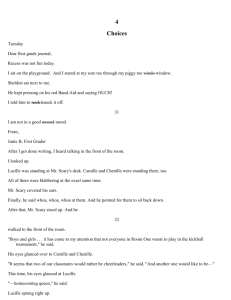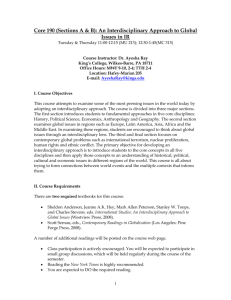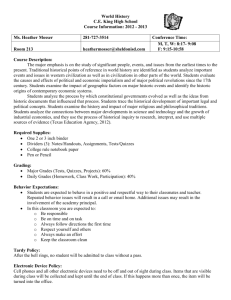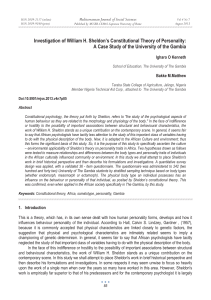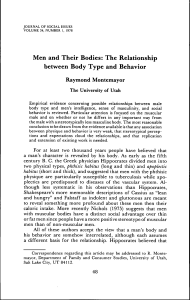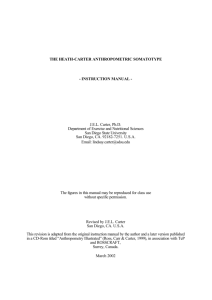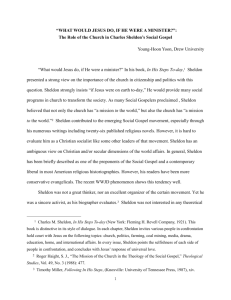William Sheldon`s Constitutional Psychology
advertisement
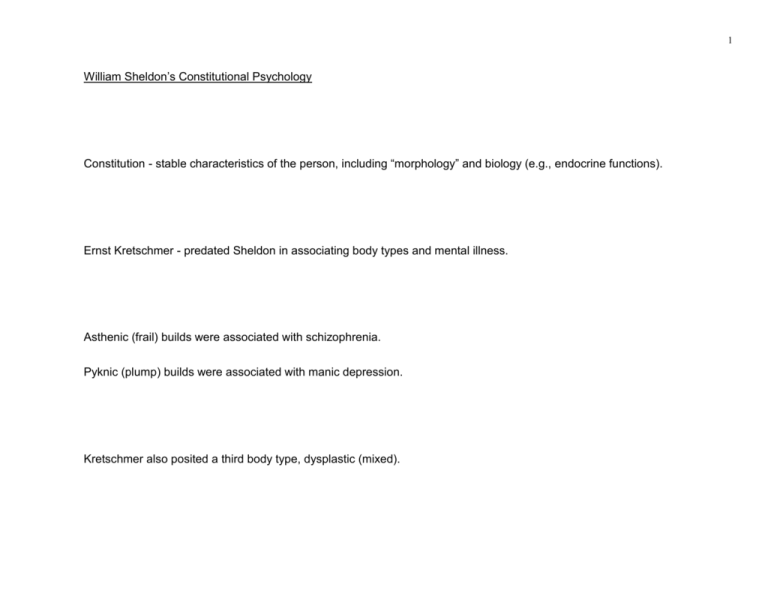
1 William Sheldon’s Constitutional Psychology Constitution - stable characteristics of the person, including “morphology” and biology (e.g., endocrine functions). Ernst Kretschmer - predated Sheldon in associating body types and mental illness. Asthenic (frail) builds were associated with schizophrenia. Pyknic (plump) builds were associated with manic depression. Kretschmer also posited a third body type, dysplastic (mixed). 2 Kretschmer’s findings may have been “spurious” because manic depression has its onset later in life than schizophrenia and later in life people are more plump or “pyknic.” genotype - genetic code or makeup of an individual phenotype - the visible properties of an organism morphology - the study of the size and shape of human beings. morphogenotype - (more than genotype or morphology) determines both physical build and behavior. Somatotype - Sheldon’s term for body type, it was his way of trying to “get at” the morphogenotype, which we cannot do directly. 3 Sheldon suggested that there were 3 somatotypes (in this order): 1. endomorphy - plump, round, and soft (dominance of the internal digestive organs). 2. mesomorphy - strong, muscular, tough (dominance of bone and muscle). 3. ectomorphy - thin, lightly muscled (dominance of skin and nervous system). each is scored on a 7 - point rating system with 4 being “average.” Arnold Schwarzenegger would likely score 1, 7, 1 Barney Fife or Pee Wee Herman might score 1, 1, 7. Chris Farley or John Candy would have scored 7, 1, 1. 4 The three names are derived from the three layers of the human embryo: 1. endoderm - which develops into the internal organs. 2. mesoderm - which develops into the muscles and bones. 3. ectoderm - which develops into the nervous system and skin. Sheldon arrived at three important somatotype indicators: 1. mature height. 2. ponderal index (height divided by the cube root of weight). 3. trunk index (chest size divided by stomach size). 5 dysplasia - appearance of the three body types in an inconsistent fashion in an individual. gynandromorphy - mixing of male and female characteristics in the body parts. “textural aspect” - fineness, attractiveness or “quality of human stock.” Sheldon developed a “mapping” system based on the three somatotypes.... ....Triangular with mesomorphy at the top, endomorphy at the lower left and ectomorphy at the lower right. 6 gender differences - females tend to cluster near the “southwest” corner of Sheldon’s “map” because: 1. females do tend to have more body fat than males and. 2. the original normative data was on males. Sheldon posited 3 dimensions of temperament (personality) 1. viscerotonia - love of comfort and food, relaxed, sociable, pleasant. 2. somatotonia - adventurous, vigorous, courageous, insensitive. 3. cerebrotonia - restrained, inhibited, fearful. Sheldon’s body type - personality correlations and scientists’ reactions to them: Sheldon’s correlations were very strong and as he predicted: 7 edomorphy with viscerotonia mesomorphy with somatotonia ectomorphy with cerebrotonia Many researchers thought his results were TOO good and questioned their validity. Walker’s (1962) study of nursery school children - findings were generally weaker than Sheldon’s but “something” was there, esp. for mesomorphy. Development - could be made easier if parents and others would take the child’s somatotype into consideration and work with it rather than trying to fight or overcome it. Sheldon posited 3 types of mental illness that could vary in severity. 8 1. affective (manic depressive) - due to low cerebrotonia. 2. paranoid (paranoid psychosis) - due to low viscerotonia. 3. heboid (schizophrenic) - due to low somatotonia. For the 3 mental illness dimensions, a 7 point rating system was used but 1 (not 4) was normal or average.... ....So, a totally normal person would score 1,1,1. Highest number indicates primary type of illness (e.g., 3-3-6 would be a schizophrenic). Total score indicates severity: 5 or less = normal, 6 to 8 = neurotic, 9 or more = psychotic. 9 Mental disorder and physique - Sheldon and others found that delinquents and criminals: tended to be “endomorphic mesomorphs, clustering in the northwest corner of his “map,” They tended to have affective (manic depressive) disorders and problems persisted into adulthood. Wittman and Katz’s study of mental disorder and physique - gave mixed results, some in agreement with Sheldon’s ideas, some not: Heboid (lack of somatotonia) patients were LOW on mesomorphy. Affective (lacking in cerebrotonia) patients were LOW on ectomorphy. Other disorder - body type correlations were less clear. 10 Relationships between Eysenck’s dimensions and Sheldon’s “temperaments”? 1. introversion and cerebrotonia? 2. extraversion and somatotonia?
